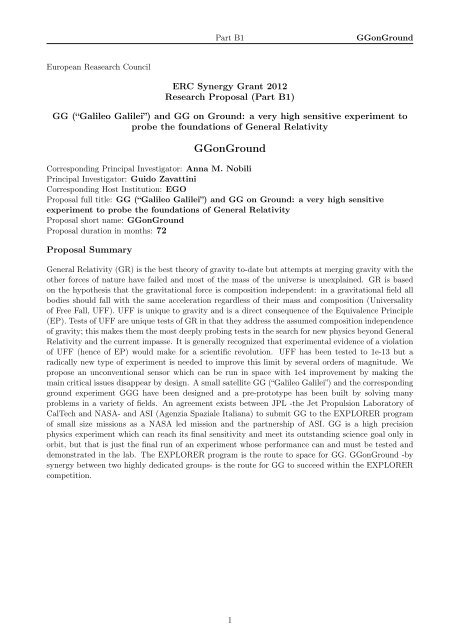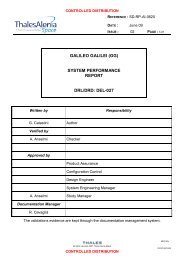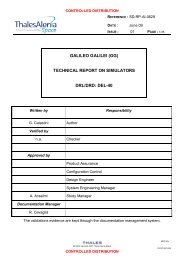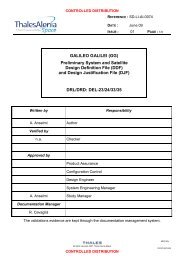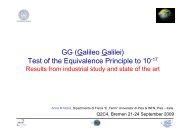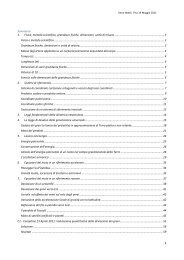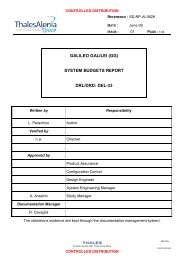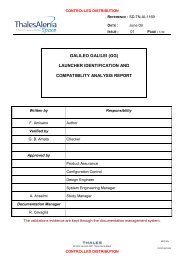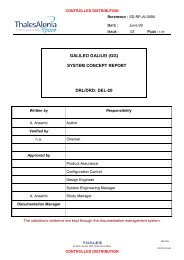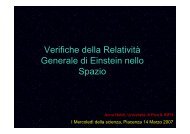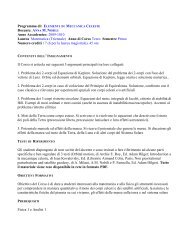GGonGround - âGalileo Galileiâ (GG
GGonGround - âGalileo Galileiâ (GG
GGonGround - âGalileo Galileiâ (GG
Create successful ePaper yourself
Turn your PDF publications into a flip-book with our unique Google optimized e-Paper software.
Part B1<strong><strong>GG</strong>onGround</strong>European Reasearch CouncilERC Synergy Grant 2012Research Proposal (Part B1)<strong>GG</strong> (“Galileo Galilei”) and <strong>GG</strong> on Ground: a very high sensitive experiment toprobe the foundations of General Relativity<strong><strong>GG</strong>onGround</strong>Corresponding Principal Investigator: Anna M. NobiliPrincipal Investigator: Guido ZavattiniCorresponding Host Institution: EGOProposal full title: <strong>GG</strong> (“Galileo Galilei”) and <strong>GG</strong> on Ground: a very high sensitiveexperiment to probe the foundations of General RelativityProposal short name: <strong><strong>GG</strong>onGround</strong>Proposal duration in months: 72Proposal SummaryGeneral Relativity (GR) is the best theory of gravity to-date but attempts at merging gravity with theother forces of nature have failed and most of the mass of the universe is unexplained. GR is basedon the hypothesis that the gravitational force is composition independent: in a gravitational field allbodies should fall with the same acceleration regardless of their mass and composition (Universalityof Free Fall, UFF). UFF is unique to gravity and is a direct consequence of the Equivalence Principle(EP). Tests of UFF are unique tests of GR in that they address the assumed composition independenceof gravity; this makes them the most deeply probing tests in the search for new physics beyond GeneralRelativity and the current impasse. It is generally recognized that experimental evidence of a violationof UFF (hence of EP) would make for a scientific revolution. UFF has been tested to 1e-13 but aradically new type of experiment is needed to improve this limit by several orders of magnitude. Wepropose an unconventional sensor which can be run in space with 1e4 improvement by making themain critical issues disappear by design. A small satellite <strong>GG</strong> (“Galileo Galilei”) and the correspondingground experiment <strong>GG</strong>G have been designed and a pre-prototype has been built by solving manyproblems in a variety of fields. An agreement exists between JPL -the Jet Propulsion Laboratory ofCalTech and NASA- and ASI (Agenzia Spaziale Italiana) to submit <strong>GG</strong> to the EXPLORER programof small size missions as a NASA led mission and the partnership of ASI. <strong>GG</strong> is a high precisionphysics experiment which can reach its final sensitivity and meet its outstanding science goal only inorbit, but that is just the final run of an experiment whose performance can and must be tested anddemonstrated in the lab. The EXPLORER program is the route to space for <strong>GG</strong>. <strong><strong>GG</strong>onGround</strong> -bysynergy between two highly dedicated groups- is the route for <strong>GG</strong> to succeed within the EXPLORERcompetition.1
Part B1<strong><strong>GG</strong>onGround</strong>1 <strong>GG</strong>onGRound project proposal: Part B1Example of link to a webpage: Galileo Galilei Web Page. Example of link to a webpage: <strong><strong>GG</strong>onGround</strong>Synergy Grant Web Page.The scientific proposal [max 15 pages, excluding the Budget Tables (obligatory), Ethical IssuesTable (obligatory) and Annex (only if applicable), and the Security Aspects Letter (only if applicable)]Describe the scientific, technical, and/or scholarly aspects of the project demonstrating the groundbreakingnature of the research, its potential impact and research methodology. Describe the significantsynergies, complementarity and added value of the group beyond the current work of the PrincipalInvestigators to enable it to jointly achieve the project’s scientific objectives. Indicate the fraction ofeach PI’s working time that will be devoted to this project, a full estimation of the real project costand any ethical considerations raised by the project. Indicate innovative ways of working together andhow the core time spent together will be utilised.2 B1–a: State of the art and objectivesThe science case. General Relativity (GR) is the best theory of gravity to-date. It governs physics atthe macroscopic and cosmic scales and has been highly successful. However, all attempts at merginggravity with the other forces of nature have failed and most of the mass of the universe is unexplained.General Relativity is based on the hypothesis that the gravitational force is composition independent:in a gravitational field all bodies fall with the same acceleration regardless of their mass andcomposition. This property is unique to gravity. It is referred to as the Universality of Free Fall (UFF)and it is a direct consequence of the Equivalence Principle (EP). It was first tested experimentally byGalileo in Pisa. Newton regarded testing it as so important that he reported the results of his ownexperiments “very accurately made” in the opening paragraph of the Principia to justify the assumptionthat “mass” and “weight” are equivalent –i.e. the equivalence between inertial and gravitationalmass. Einstein went much further and stated what he later referred to as the “happiest thought of mylife”: if all bodies fall equally fast, in a freely falling frame gravity has –locally– no dynamical effects.UFF is therefore equivalent to making the “hypothesis of complete physical equivalence” between agravitational field and an accelerated frame([1], Ch. V “Principle of relativity and gravitation”, Sec. 17“Accelerated reference system and gravitation”). Starting from this hypothesis –published in 1907– andextending it globally, nine years later Einstein formulated the General Theory of Relativity, which istherefore founded on the UFF. Any violation of UFF (hence of EP) would violate General Relativityas well as all metric theories of gravity.UFF experiments are unique tests of General Relativity in that –unlike all others– they address theassumed composition independence of gravity which sets it aside from all other forces of nature; thisfact makes them the most deeply probing tests in the search for new physics beyond General Relativityand the current impasse.It is widely recognized that experimental evidence of a violation of the UFF (hence of EP) wouldmake for a scientific revolution, opening a totally new era in physics as it rarely happens. Even a nullresult (no violation) –if proven to very high precision– would constrain physical theories for decadesto come. Either way, improving UFF tests by several orders of magnitude would be ground-breaking.State of the art. Stringent limits to the validity of UFF have been set by small size experimentsin which the test masses are mechanically coupled by means of a very sensitive torsion balance thatis slowly rotating. In terms of differential acceleration from the Earth they have measured ∆a ⊕ ≃1.69 · 10 −15 ms −2 , finding no violation to η = 10 −13 [2], (η ≡ ∆a ⊕ /a ⊕ , a ⊕ ≃ 1.69 · 10 −2 ms −2 at theirlatitude). Despite the much larger free fall acceleration, Galileo-like mass dropping tests have been byfar less sensitive than torsion balances. The reasons are twofold: thw time of fall of just a few secondsand release errors the test masses. Careful physical modeling and analysis of laser ranging data to thecorner cube reflectors left on the surface of the Moon by the Apollo missions have set a limit similarto that of torsion balances for the Moon and Earth falling in the gravitational field of the Sun [3].However, although a violation is expected at some point, no firm prediction exists as to the precise2
Part B1<strong><strong>GG</strong>onGround</strong>level at which it should occur.Slowly rotating torsion balances have hit the level of thermal noise ([4], Fig. 20); lunar laserranging tests are close to their limit [5]. Even one order of magnitude improvement may be difficultwith these techniques. Tests based on dropping cold atoms have achieved η = 10 −7 [6] (6 orders ofmagnitude worse than torsion balances) and have yet to match the best result ∆g/g ≃ 3·10 −9 obtainedin measuring the local gravitational acceleration by dropping a single species of atoms [7].A radically new type of experiment is necessary to improve the current experimental limit in UFFand EP tests by several orders of magnitude thus deeply probing this physical domain so far unexplored.The case for a test of UFF and EP in low Earth orbit. Back in the 1970s it was realizedthat a torsion balance kind of experiment in which two weakly coupled test masses orbit the Earthinside a low altitude spacecraft would be equivalent to dropping them from an “infinitely” tall tower,yielding both a stronger signal from Earth (by about 3 orders of magnitude) and a time of fall aroundit as long as the mission duration (and no mass release problems). A violation signal (pointing to thecenter of the Earth) would appear at the (low) orbital frequency of the satellite –of a few 10 −4 Hz– tobe upconverted to higher frequency by rotation of the spacecraft in order to reduce noise ([8], [9], [10]).Absence of weight and isolation of the laboratory (the spacecraft) are additional great advantages.Overall, in low Earth orbit an improvement by 4 orders of magnitude, down to η = 10 −17 , is withinreach and the idea has attracted the interest of NASA and later on of other space agencies.At h ≃ 600 km altitude where the attraction from the Earth is g(h) ≃ 8 ms −2 , the goal η = 10 −17sets the differential acceleration between the proof masses which must be measured: a = η g(h) ≃8 · 10 −17 ms −2 . This shows that a sensor in space only a factor 20 better than torsion balances wouldmake a 10 4 times better test. If the masses are coupled with a natural period of differential oscillationT d , the relative displacement to be measured is r = a (Td 2/4π2 ): the weaker the coupling, the longerthe differential period, the more sensitive the instrument.The case for “Galileo Galilei” (<strong>GG</strong>) to test UFF and EP to 10 −17 . All investigators agreethat in orbit the proof masses should be “concentric” cylinders –with the centers of mass as close aspossible to each other to reduce classical differential effects due to non uniformity of the gravitationalfield– and should rotate, so as to upconvert the signal to higher frequency (the higher the better). Thequestion is: should the concentric test cylinders be sensitive (i.e. weakly coupled) along the symmetryaxis (1D accelerometer) and rotate around an axis perpendicular to it, or else should they rotate aroundthe symmetry axis and be sensitive in the plane perpendicular to it (2D accelerometer)?Although spinning around an axis which is not the symmetry axis is unnatural, the choice ofcoupling the test cylinders in 1D prevailed, despite the fact that it essentially rules out fast rotationbecause it is well known that forcing an oscillator above its natural frequency causes the forcing signalto be attenuated. This choice made it necessary to solve the main critical issues of a high sensitivespace experiment by brute force, most notably by requiring that the experiment be carried out incryogenic conditions, close to absolute zero temperature [11].The signal to be measured asks for both weak coupling and fast spin, a situation which is known inRotordynamics as rotation in supercritical regime: it makes fast rotation possible through autocentering,but it is an established fact that it cannot work in 1D –it works only if coupling occurs in 2D ([12], [13]).The “Galileo Galilei” (<strong>GG</strong>) space experiment was proposed in the mid 1990s by A. M. Nobili andcolleagues who realized that this choice makes most of the critical issues disappear by design: fastrotation does not attenuate the target low frequency signal; the centers of mass of the test cylinderscenter on each other by physics laws; many dangerous effects are DC; cryogenics is not required; fastrotation and cylindrical symmetry allow passive 1-axis stabilization of the spacecraft and significantlyreduce its size and complexity; etc... ([14], [15]). Papers have been published showing the advantagesof the novel idea of a differential accelerometer with the proof masses weakly coupled in 2D androtating faster than their natural oscillation frequency ([16], [11], [17]). The <strong>GG</strong> space mission hasbeen investigated with funding from ASI (Agenzia Spaziale Italiana) ([18]). More importantly, the newsensor design has allowed a full-size 1-g version of it –with the same number of degrees of freedom andthe same dynamical features– to be built and tested on ground. <strong>GG</strong> on Ground (<strong>GG</strong>G) has been set upwith funding from ASI and INFN ([19] ÷ [22]); the latest experimental results (Fig.??) demonstrate3
Part B1<strong><strong>GG</strong>onGround</strong>Figure 1: Xxxxthat weak coupling of large proof masses and sensitivity to small forces are compatible with rapidrotation; in fact, it is rapid rotation that makes sensitivity to small forces possible.The most relevant physical property of the <strong>GG</strong>/<strong>GG</strong>G novel sensor has been demonstrated veryrecently [23]: thermal noise due to internal damping which competes with the low frequency signalof interest is reduced as 1/ √ ν spin (with no signal attenuation) making rapid rotation more effectivethan cryogenics in reducing thermal noise. Taking into account also residual gas damping and eddycurrents it turns out that <strong>GG</strong> can perform a full test to 10 −17 in just 1 d [24]; in a 9-month mission allnecessary checks against systematics can be performed so that the question as to whether the result isnew physics or else it is due to a tiny known disturbance –hence it is a null result– can be establishedbeyond doubt [25].Recent collaboration with JPL (Jet Propulsion Laboratory, CalTech-NASA) has shown that anoptical read-out based on the very low noise laser interferometry gauge developed and demonstratedat JPL will allow <strong>GG</strong> to fully exploit its very short integration time. The collaboration has led to anagreement between JPL and ASI to submit <strong>GG</strong> to the EXPLORER program as a NASA led missionand the partnership of ASI, with M. Shao (JPL) as PI and A. M. Nobili as Co-PI. EXPLORER is along time program of NASA dedicated to flying small size missions every few years years; the Nobelprize winner COBE was one of them. The 2010 Decadal Astronomy has ranked the EXPLORERprogram as its second highest priority and has advised NASA to further strengthen it. EXPLORERis the right framework for a small mission like <strong>GG</strong> –which is well below the size of ESA missions– andgiven that ASI cannot afford a full mission but would be willing contribute to a NASA led missionwith a significant Italian rôle.The case for <strong><strong>GG</strong>onGround</strong>. <strong>GG</strong> is a high precision physics experiment which can reach its goalonly in orbit, but that is just the final run of an experiment whose performance can and must be testedand demonstrated in the lab. The EXPLORER program is the only possible route to space for <strong>GG</strong>,but for <strong>GG</strong> to enter in the EXPLORER competition and eventually be selected for flight the <strong>GG</strong>Glab experiment must prove –by sufficiently isolating the sensor from ground noise sources and with anadequate read out– that the sensor in space can meet its target.Synergy between the Corresponding PI Nobili, who has led <strong>GG</strong> and <strong>GG</strong>G so far, and the PIZavattini, who will lead the efforts for implementing a low noise laser gauge can considerably improve<strong>GG</strong>G to meet the goal set in Table 1. Fig. ?? shows that <strong>GG</strong>G has reached a sensitivity of 8.5 ·10 −11 ms −2 in 30 d, while <strong>GG</strong> must reach a <strong>GG</strong> = 8 · 10 −17 ms −2 to meet its goal. We state withconfidence that <strong>GG</strong>G can improve by 5 orders of magnitude its current performance to reach a <strong>GG</strong>G =10a <strong>GG</strong> ≃ 8 · 10 −16 ms −2 (slightly better than torsion balances) because –as the noise budget in thesame table shows– there are no fundamental limitations. The main limitations are terrain and bearingslow frequency tilt noise. Terrain tilt input noise at ν <strong>GG</strong> has been measured ([26], [27]), its effect on the4
Part B1<strong><strong>GG</strong>onGround</strong>Figure 2: Xxxxtest cylinders is understood (it is expressed by a simple analytical formula with few parameters) andthere is no doubt that the current suspensions can be improved (only a factor 4 is needed) and theapparatus properly modified to meet the goal. Air bearing is known to be several orders of magnitudeless noisy than ball bearing (the vacuum chamber enclosing the torsion balance rotates on air bearing)and a solution is under study for <strong>GG</strong>G in which only the experiment rotates, not the chamber. Thisis feasible and can be realized by A. M. Nobili with the collaboration of Dr. R. Pegna who hassignificantly contributed to the current <strong>GG</strong>G performance and can effectively co-lead this activity. Atfull performance the capacitance bridges are no longer adequate and must be replaced by the lasergauge; this effort can be successfully led by the PI G. Zavattini based on his experience in Fabry-Perotinterferometry, with collaboration and advise from Dr. M. Shao (JPL, CA, USA) who has alreadydeveloped, built and demonstrated a very low noise laser gauge.The roadmap Table 2 shows that this remarkable progress can be done in steps within the first3 years of the project, to secure the success of <strong>GG</strong> through the various stages of the EXPLORERselection process (release of next Call is expected at the end of 2013). The remaining 3 years will bedevoted –as outlined in Table 3– to bridge the remaining gap with laser gauge noise required in spaceand to manufacture and test the most crucial components of the space sensor. The final goal is toensure the success of the experiment in space and to strengthen its European contribution.Required funding (9592600 e total for 6 yr) and PIs time on the the project are given in the BudgetTables. Both PIs are strongly dedicated to this project, for their time is limited only by teaching duties(AMN will leave teaching the second year). Funding is dominated by personnel cost due to the lack offunds in Italy to employ researchers and the very limited number of permanent ones; and also to thewide variety of disciplines relevant to this project and need to be mastered.EGO is the best Institution to host a European project in experimental gravitation. <strong><strong>GG</strong>onGround</strong>needs a specific but limited laboratory space (roughly 50 m 2 with about 6 m high roof) where thecurrent apparatus and equipment (acquired with ASI and INFN funds) will be moved. All activitywill be carried out by the two PIs and their collaborators.References[1] A. Einstein, Jahrbuch der Radioaktivität und Elektronik, 4, 411-462 (1907)[2] S. Schlamminger et. al., Phys. Rev. Lett. 100, 041101 (2008)[3] J. G. Williams, S. G. Turyshev & D. H. Boggs, Phys. Rev. Lett. 93, 261101 (2004)[4] E. G. Adelbergeret al., Progress in Particle and Nuclear Physics 62, 102 (2009)[5] A. M. Nobili et al., General Relativity & Gravitation 40, 1533Ű1554 (2008)5
Part B1<strong><strong>GG</strong>onGround</strong>Figure 3: Xxxx[6] S. Fray et. al., Phys. Rev. Lett. 93, 240404 (2004)[7] A. Peters, K.Y. Chung & S. Chu, Nature 400, 949 (1999)[8] P. K. Chapman, A. J. Hanson, Proc. Conf. on Exp. Tests of Grav. Theories, JPL Pub. 228 (1971)[9] P. W. Worden, Jr., PhD Thesis, Stanford University, Stanford (CA) (1976)[10] P. W. Worden, Jr., Acta Astronautica, 5, 27 (1987)[11] A. M. Nobili et al., Phys. Rev. D Rapid Commun. 63, 101101(R) (2001)[12] J. P. Den Hartog, Mechanical Vibrations, Dover Publ. Inc N.Y. 1985 (first published in 1934)[13] S. H. Crandall, J. Sound Vib. 11(1), 3-18, (1970)[14] A. M. Nobili et al., J. Astronaut. Sc. 43, 219-242 (1995)[15] A. M. Nobili et al., New Astronomy 3 175Ű218 (1998)[16] A. M. Nobili et al., Classical Quantum Gravity 16, 1463-1470 (1999)[17] A. M. Nobili et al., New Astronomy 7 521-529 (2002)[18] <strong>GG</strong> Phase A Study Report, ASI (1998), <strong>GG</strong> Phase A-2 Study Report (2009)[19] A. M. Nobili et al., New Astronomy 8 371-390 (2003)[20] G. L. Comandi et al., Rev. Sci. Instrum. 77 034501 1-15 (2006)[21] G. L. Comandi et al., Rev. Sci. Instrum. 77 034502 1-15 (2006)[22] A. M. Nobili et al., Int. J. of Modern Physics D, 16 2259-2270 (2007)[23] R. Pegna et al., Phys. Rev. Lett. 107, 200801 (2011)[24] A. M. Nobili et al., Integration time in very high sensitive EP tests in space, to be submitted[25] A. M. Nobili, et al., Null checks in space experiments to test EP, to be submitted[26] G. L. Comandi, PhD Thesis, University of Pisa, Pisa, Italy (2004)[27] V. Iafolla, private communication (2012)xxxa. State of the art and objectives: Specify clearly the objectives of the proposal, in the context ofthe state of the art in the field. When describing the envisaged research it should be indicated how andwhy the proposed work is important for the field, and what impact it will have if successful, such ashow it may open up new horizons or opportunities for science, technology or scholarship. Specify anyparticularly challenging or unconventional concepts and approaches of the proposal, including multi -or interdisciplinary aspects.6
Part B1<strong><strong>GG</strong>onGround</strong>Figure 4: Xxxx7
Part B1<strong><strong>GG</strong>onGround</strong>Figure 5: Xxxx8
Part B1<strong><strong>GG</strong>onGround</strong>3 B1–b: Methodology9
Part B1<strong><strong>GG</strong>onGround</strong>Differential acceleration betweentest massesa @ 1.7 · 10 −4 Hz<strong><strong>GG</strong>onGround</strong> goal vs <strong>GG</strong> goal in spacea [ms −2 ]r = a T 2 d4π 2 [m]<strong>GG</strong> goal in space a <strong>GG</strong> = ηg(h) 8 · 10 −17 6 · 10 −13 1(upconverted to 1 Hz) (η = 10 −17 , h ≃ 600 km) (T d ≃ 540 s)<strong><strong>GG</strong>onGround</strong> a <strong>GG</strong>G = 10a <strong>GG</strong> 8 · 10 −16 3.2 · 10 −14 30goal (upconverted to 0.2 ÷ 3 Hz) (T d ≃ 40 s)IntegrationtimeT int [d]<strong><strong>GG</strong>onGround</strong> noise budget @ 1.7 · 10 −4 HzNoise Source ∆a Integrated ∆a ∆r Integrated ∆r Conditions and physical data(T int = 30 d) (T d ≃ 40 s) (T int = 30 d)−13 ms−2[10 √Hz] [10 −16 ms −2 ] [10 −11 √ mHz] [10 −14 m]Tilt noise sources: a tilt =kc k shaftmgL M tot gL shaftgθ tilt−6 radterrain 8.2 5.1 3.3 2.1 θ terrain ≃ 8 · 10 √Hz−6 radair bearing 4.1 2.5 1.7 1.0 θ ab ≃ 4 · 10 √Hzk c ≃ k shaft ≃ 0.04 Nm/radm = 10 kg L = 0.5 mM tot ≃ 80 kg L shaft ≃ 4 mThermal noise sources[23],[24]suspensions 1.3 0.8 0.5 0.3 Q=20000, ν spin = 0.2 Hzeddy currents 1.3 0.8 0.5 0.3 no µmetal magnetic shieldresidual gas 0.5 0.3 0.2 0.1 2 cm gap, P = 10 −4 PaReadOut noise: a ROnoise = (4π 2 /Td 2 )r ROnoiselaser gauge 7.4 4.6 3.0 1.8 T d ≃ 40 sTotal noise 12 7.4 4.8 3.0Table 1: <strong><strong>GG</strong>onGround</strong> goal and noise budget<strong><strong>GG</strong>onGround</strong> RoadmapTime (Months)Performance achievedt 0 a 0 = 8.5 · 10 −11 ms −2 (INFN lab San Piero, Pisa; ASI and INFN funding; Fig. ??)First 18–month period targets6 t 0 + 6 a 1 = 2.8 · 10 −12 ms −2 (T d = 14.8 s r capRO = 1.45 · 10 −8 m/ √ Hz; can be done with capacitanceread out and ball bearings, requires weaker joints by a factor 4)12 t 0 + 12 a 2 = 7.7 · 10 −14 ms −2 (T d = 40 s r capRO = 3 · 10 −9 m/ √ Hz; can be done with capacitancereadout and ball bearings, requires 10 times longer suspension shaft)18 t 0 +18 = t 1 a 3 = 5.6 · 10 −15 ms −2 (T d = 40 s r laserRO = 2.2 · 10 −10 m/ √ Hz; requires preliminary version ofair bearings and laser metrology)Second 18–month period targets24 t 1 + 6 reduce air bearings and rotation noise30 t 1 + 12 reduce laser gauge read out noise36 t 1 +18 = t 2 a 4 = 7.7 · 10 −16 ms −2 (T d = 40 s r laserRO = 3.0 · 10 −11 m/ √ Hz; requires air bearings to fullperformance and improved laser metrology)Third 18–month period targets42 t 2 + 6 Install rotating whirl control (as required in <strong>GG</strong>)48 t 2 + 12 Measure patch effects and demonstrate that they are not relevant; improve sensitivity to effectfrom Sun @ 24 h by Phase Sensitive Detection in preparation for analysis of space data54 t 2 +18 = t 3 Optimize test masses different composition, manufacture test masses, measure their quadrupolemoments and confirm requirementsFourth 18–month period targets60 t 3 + 6 Manufacture suspensions required for <strong>GG</strong> in space, measure their elastic constants and qualityfactors and confirm fulfilment <strong>GG</strong> requirements66 t 3 + 12 Demonstrate on bench laser gauge read out noise to r laserRO ≃ 10 −12 m/ √ Hz @ 1 ÷ 2 Hz72 t 3 +18 = t 4 Test PZTs and inchworms to demonstrate feasibility of balancing in spaceTable 2: <strong><strong>GG</strong>onGround</strong> Roadmap10
Part B1<strong><strong>GG</strong>onGround</strong>Figure 6: Xxxxxxxxxb. Methodology Describe the proposed methodology and feasibility in detail including, as appropriate,key intermediate goals. Explain and justify the methodology in relation to the state of the art,including any particularly novel or unconventional aspects addressing ’high-gain/high-risk’ balance,i.e. if successful the payoffs will be very significant, but there is a higher-than- normal risk that theresearch project does not entirely fulfil its aims.11
Part B1<strong><strong>GG</strong>onGround</strong>Figure 7: Xxxx12
Part B1<strong><strong>GG</strong>onGround</strong>4 B1–c: Resources and budget tablesBudget Table (in e) for the Corresponding Principal Investigator Anna M. NobiliDirect CostsCost Months Months Months Months TotalCategory 1–18 19–36 37–54 55–72Personnel:PI 44000 44000 36000 36000 160000Senior Staff (1) 118500 118500 118500 118500 474000Post Docs (1) 67500 67500 67500 67500 270000Students (PhD, 2) 60000 60000 60000 60000 240000Other (Dr. R. Pegna) 118500 118500 118500 118500 474000Other (1 mech. engineer) 67500 67500 67500 67500 270000Other (Dr. G. Catastini) 66000 66000 132000Other (Dr. D.M. Lucchesi) 13500 13500 13500 13500 54000Other (1 Junior Staff) 105000 105000 105000 105000 420000Other (1 admin. assistant) 53550 53500 53550 53550 214200Total Personnel: 2708200Other Direct Costs:Equipement (eligible fraction only) 235000 275000 275000 275000 1060000Consumables 25000 25000 25000 25000 100000Travel 92700 92700 100950 100950 387300Publications, dissemination etc.. 49500 49500 49500 49500 198000Other (removal and lab set up) 50000 50000Total Other Direct Costs 452200 442200 450450 450450 1795300Total Direct Costs 1100250 1090250 1156500 1156500 4503500Indirect Max 20% of Direct Costs 220050 218050 231300 23130 900700CostsSubcontracting (No Overheads) 10000 10000 10000 10000 40000Costs (auditing)Total Costs (By Year and Total) 1330300 1318300 1397800 1397800 5444200of Project:RequestedGrant:(By Year and Total) 1330300 1318300 1397800 1397800 5444200Working time the PI A.M. Nobili dedicates to the project over the period of the grantMonths Months Months Months Average1–18 19–36 37–54 55–7273.3% 73.3% 60% 60% 67%13
Part B1<strong><strong>GG</strong>onGround</strong>Direct CostsBudget Table (in e) for the Principal Investigator Guido ZavattiniCost Months Months Months Months TotalCategory 1–18 19–36 37–54 55–72Personnel:PI 24000 36000 36000 36000 132000Senior Staff (1) 118500 118500 118500 118500 474000Post Docs (1) 67500 67500 67500 67500 270000Students (PhD, 1) 30000 30000 30000 30000 120000Other (Dr. Mike Shao) 37500 37500 37500 37500 150000Other (2 Junior Staff) 210000 210000 210000 210000 840000Total Personnel: 487500 499500 499500 499500 1986000Other Direct Costs:Equipement (eligible fraction only) 210000 230000 200000 200000 840000Consumables 25000 25000 25000 25000 100000Travel 102000 125000 92000 92000 411000Publications, dissemination etc 30000 30000 30000 30000 120000OtherTotal Other Direct Costs 367000 410000 347000 347000 1471000Total Direct Costs 854500 909500 846500 846500 3457000Indirect Max 20% of Direct Costs 170900 181900 169300 169300 691400CostsSubcontracting (No Overheads)CostsTotal Costs (By Year and Total) 1025400 1091400 1015800 1015800 4148400of Project:RequestedGrant:(By Year and Total) 1025400 1091400 1015800 1015800 4148400Working time the PI G. Zavattini dedicates to the project over the period of the grantMonths Months Months Months Average1–18 19–36 37–54 55–7240% 60% 60% 60% 50%14
Part B1<strong><strong>GG</strong>onGround</strong>Summary Table for the Entitre Budget (in e)Cost Months Months Months Months TotalCategory 1–18 19–36 37–54 55–72Personnel:PI 68000 80000 72000 72000 292000Senior Staff 237000 237000 237000 237000 948000Post Docs 135000 135000 135000 135000 540000Students 90000 90000 90000 90000 360000Other 605550 605550 671550 671550 2554200Total Personnel: 1135550 1147550 1205550 1205550 4694200Direct CostsIndirectCostsSubcontractingCosts (auditing)Total Costsof Project:RequestedGrant:Other Direct Costs:Equipement 445000 505000 475000 475000 1900000Consumables 50000 50000 50000 50000 200000Travel 194700 217700 192950 192950 798300Publications, dissemination etc 79500 79500 79500 79500 318000Other 50000 50000Total Other Direct Costs 819200 852200 797450 797450 3266300Total Direct Costs 1954750 1999750 2003000 2003000 7960500Max 20% of Direct Costs 390950 399950 400600 400600 1592100(No Overheads) 10000 10000 10000 10000 40000(By Year and Total) 2355700 2409700 2413600 2413600 9592600(By Year and Total) 2355700 2409700 2413600 2413600 9592600c. Resources (incl. project costs) It is strongly recommended to use the budget table template tofacilitate the assessment of resources by the panels (see Annex 3). The summary and the breakdownof the budget following the template is subdivided in personnel costs, equipment and infrastructure,consumables, travel, publication costs, and any envisaged subcontracts. This table has to be providedby each PI and a final table will summarise the overall budget breakdown for the roject. Thesefigures should be summarised in the financial information form A3 as well (although according to hostinstitutions and not according to PIs).Describe the size and nature of the Synergy group, including each PI and where appropriate, theirkey team members and their roles. The participation of team members engaged by another institutionbesides that of the participating PIs should be justified in relation to the additional financial cost thismay impose to the project (see section 1.1.3 of this guide). Describe other necessary resources, such asinfrastructure and equipment. Specify any existing resources that will contribute to the project. It isadvisable to include a short technical description of the equipment requested, a justification of its needas well as the intensity of its planned use. Please ensure that a short narrative description is providedfor all budget lines for which funding is requested.State the amount of funding considered necessary to fulfil the objectives for the duration of theproject. This should be a reasoned estimate of the projects costs. Each PI should take into account thepercentage of their dedicated time (each PI is expected to devote at least 30% of their total workingtime to the ERC-funded project while spending at least 50total working time in an EU Member Stateor Associated Country) to run the ERC-funded activity when calculating their personnel costs. Includethe direct costs of the project plus a flat rate financing of indirect costs on the basis of 20% of thetotal eligible direct costs (excluding subcontracting and the costs of reimbursement of resources madeavailable by third parties which are not used on the premises of the beneficiary) towards overheads.The project cost estimation should be as accurate as possible. The evaluation panels assess theestimated costs carefully; unjustified budgets will be consequently reduced.15
Part B1<strong><strong>GG</strong>onGround</strong>There is no minimum contribution per year; the requested contribution should be in proportion tothe actual needs to fulfil the objectives of the project.5 B–d: Ethical and security-sensitive issuesResearch on Human Embryo/ Foetus YES PageDoes the proposed research involve human Embryos?Does the proposed research involve human Foetal Tissues/ Cells?Does the proposed research involve human Embryonic Stem Cells (hESCs)?Does the proposed research on human Embryonic Stem Cells involve cells in culture?Does the proposed research on Human Embryonic Stem Cells involve the derivation of cellsfrom Embryos?I CONFIRM THAT NONE OF THE ABOVE ISSUES APPLY TO MY PROPOSAL YESResearch on Humans YES PageDoes the proposed research involve children?Does the proposed research involve patients?Does the proposed research involve persons not able to give consent?Does the proposed research involve adult healthy volunteers?Does the proposed research involve Human genetic material?Does the proposed research involve Human biological samples?Does the proposed research involve Human data collection?I CONFIRM THAT NONE OF THE ABOVE ISSUES APPLY TO MY PROPOSAL YESPrivacy YES PageDoes the proposed research involve processing of genetic information or personal data (e.g.health, sexual lifestyle, ethnicity, political opinion, religious or philosophical conviction)?Does the proposed research involve tracking the location or observation of people?I CONFIRM THAT NONE OF THE ABOVE ISSUES APPLY TO MY PROPOSAL YESResearch on Animals YES PageDoes the proposed research involve research on animals?Are those animals transgenic small laboratory animals?Are those animals transgenic farm animals?Are those animals non-human primates?Are those animals cloned farm animals?I CONFIRM THAT NONE OF THE ABOVE ISSUES APPLY TO MY PROPOSAL YESResearch Involving non-EU Countries (ICPC Countries) YES PageIs the proposed research (or parts of it) going to take place in one or more of the ICPCCountries?Is any material used in the research (e.g. personal data, animal and/or human tissue samples,genetic material, live animals, etc) :a) Collected in any of the ICPC countries?b) Exported to any other country (including ICPC and EU Member States)?I CONFIRM THAT NONE OF THE ABOVE ISSUES APPLY TO MY PROPOSAL YESDual Use YES PageResearch having direct military useResearch having the potential for terrorist abuseI CONFIRM THAT NONE OF THE ABOVE ISSUES APPLY TO MY PROPOSAL YESSecurity-Sensitive IssuesThere are no security-sensitive issues16


